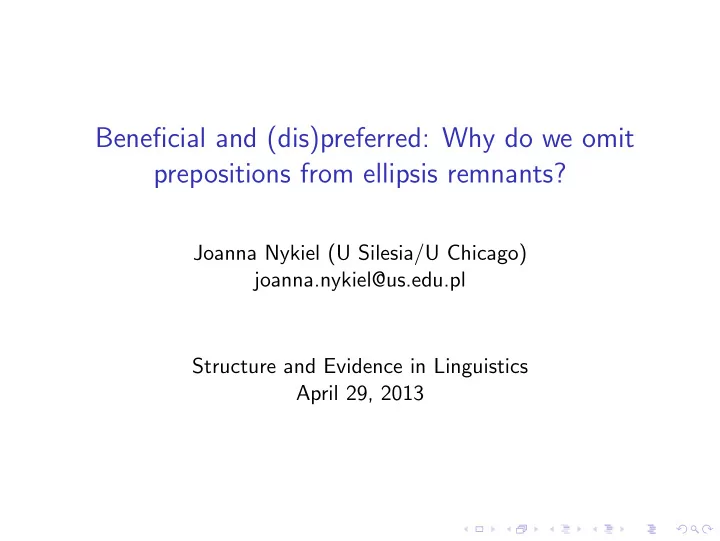

Beneficial and (dis)preferred: Why do we omit prepositions from ellipsis remnants? Joanna Nykiel (U Silesia/U Chicago) joanna.nykiel@us.edu.pl Structure and Evidence in Linguistics April 29, 2013
Introduction ◮ Sluicing is a construction where the remnant is a stranded wh-phrase with the semantics of an interrogative clause (1) Scott came for an audition , but I don’t know (for) which . ◮ Fragment answers involve a stranded XP with the semantics of a declarative clause (2) A: What are you majoring in ? B: (In) information systems . ◮ Remnants have PPs as correlates ( for an audition and what in ) but use of the prepositions (Ps) in remnants is optional.
Problem ◮ ‘no-one has even hinted at how to account for these facts without using a theory of preposition-stranding’ (Merchant 2010)
Preposition-Stranding Generalization ◮ A language L will allow preposition-stranding under Sluicing just in case L allows preposition stranding under regular WH-Movement. (Merchant 2001:107) (3) Kelly is working on something , but I don’t know what Kelly is working on. ◮ Predicts that English and Norwegian, but not Polish, tolerate remnants without Ps
Processing account ◮ Building on Ariel (1990, 2001) ◮ Anaphoric expressions code mental accessibility of their antecedents: More informative expressions point to low-accessibility antecedents ◮ Remnants with Ps are more informative than remnants without Ps → Remnants with Ps point to low-accessibility correlates ◮ All languages should tolerate remnants without Ps
Mental accessibility of correlates ◮ Determined by informativity (see Ariel 1990, Hofmeister 2007) ◮ Metric: syntactic and semantic features (max. 10) ◮ CAT, number, grammatical gender, case, animacy, humanness, concreteness, natural gender, attributive (age, color, size, shape), referent (singleton or nonsingleton set) ◮ a gentleman has the informativity score of 0.70 ◮ something has the informativity score of 0.40
Evidence for informativity effects ◮ Correlates with higher informativity scores prefer remnants without Ps ◮ Norwegian eye movement data: progressive vs. regressive eye movements ◮ Norwegian acceptability judgment data ◮ Polish corpus data ◮ Polish acceptability judgment data ◮ English corpus data ◮ English 100-split task (see Ford and Bresnan 2010)
Evidence for informativity effects: English ◮ Reprise questions prefer remnants with Ps (4) A: There are many women with that? B: With what? (5) A: Have you heard of Yani? B: Of who? ◮ But not if the correlate contains an NP (6) A: What happened with the car? B: What car?
Remnants with Ps have the upper edge! ◮ Eye movement study of Norwegian sluicing ◮ First fixation duration on remnant region always shorter for remnants with Ps (provided that Ps were fixated) than for remnants without Ps ( p < 0 . 003) ◮ Remnants with Ps provide better retrieval cues
Overall preferences ◮ Norwegian and English reveal an overall preference for remnants without Ps ◮ Polish reveals an overall preference for remnants with Ps ◮ Why?
Why? ◮ Availability of multi-word verbs (i.e., prepositional verbs) is crucial ◮ Combinations of V and P whose compositionality is gradient (Brinton and Traugott 2005) ◮ English and Norwegian have multi-word verbs, but Polish doesn’t ◮ English as a test case
Identifying English multi-word verbs ◮ Entailment tests (Hawkins 2000, 2004) ◮ Verb entailment test If [X V PP] entails [X V], then assign Vi. If not, assign Vd. ◮ Pro-verb entailment test If [X V PP] entails [X Pro-V PP] or [something Pro-V PP] for any pro-verb sentence listed below, then assign Pi. If not, assign Pd. Pro-verb sentences: X did something PP; X was PP; something happened PP; something was the case PP; something was done (by X) PP .
Levels of semantic dependence ◮ Level 0: semantic independence ◮ Level 1: one-way semantic dependence, where either V or P depends on the other category ◮ Level 2: two-way semantic dependence, where V and P depend on each other
English data Figure: Realization of ellipsis remnants by dependency level of V and P
Reanalysis ◮ Where a V and P show some level of semantic dependence, they’re on their way to semantic reanalysis (though not necessarily syntactic): [V + PP] → [[V + P] + POBJ]] ◮ The human processor needs simultaneous access to both (Hawkins 2004) (7) A: Pat fell for a scam again, but I’m not sure *for what scam. (8) A: Pat came across something in the basement, but I don’t know *across what.
Discussion ◮ Remnants with Ps facilitate retrieval of correlates ◮ Correlates with high informativity scores prefer remnants without Ps ◮ But crucially, availability of multi-word verbs influences overall preference for remnants with Ps or for remnants without Ps ◮ We have an account that makes no reference to availability of P-stranding
Thank you!
Recommend
More recommend